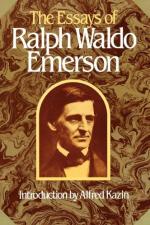[Footnote 243: Thebes, a celebrated ruined city of Upper Egypt.]
[Footnote 244: Palmyra, a ruined city of Asia situated in an oasis of the Syrian desert, supposed to be the Tadmor built by Solomon in the wilderness (II. Chr., viii. 4).]
[Footnote 245:
“Vain, very vain, my
weary search to find
That bliss which only
centers in the mind....
Still to ourselves in
every place consign’d,
Our own felicity we
make or find.”
GOLDSMITH
(and JOHNSON),
The
Traveler, 423-32.
“He that has light within his own clear breast
May sit i’ th’ center, and enjoy bright day;
But he that hides a dark soul, and foul thoughts,
Benighted walks under the mid-day sun;
Himself in his own dungeon.”
MILTON, Comus, 381-5.
Compare also Paradise Lost, I, 255-7.]
[Footnote 246: Vatican, the palace of the pope in Rome, with its celebrated library, museum, and art gallery.]
[Footnote 247: Doric, the oldest, strongest, and simplest of the three styles of Grecian architecture.]
[Footnote 248: Gothic, a pointed style of architecture, prevalent in western Europe in the latter part of the middle ages.]
[Footnote 249: Never imitate. Emerson insists on this doctrine.]
[Footnote 250: Shakespeare (1564-1616), the great English poet and dramatist. He is mentioned in Emerson’s writings more than any other character in history, and is taken as the type of the poet in his Representative Men.
“O mighty poet! Thy works are not as those of other men, simply and merely great works of art; but are also like the phenomena of nature, like the sun and the sea, the stars and the flowers,—like frost and snow, rain and dew, hailstorm and thunder, which are to be studied with entire submission of our own faculties, and in the perfect faith that in them there can be no too much or too little, nothing useless or inert,—but that, the further we press in our discoveries, the more we shall see proofs of design and self-supporting arrangement where the careless eye had seen nothing but accident!”—DE QUINCY.]
[Footnote 251: Benjamin Franklin (1706-1790), American philosopher, statesman, diplomatist, and author. He discovered the identity of lightning with electricity, invented the lightning-rod, went on several diplomatic missions to Europe, was one of the committee that drew up the Declaration of Independence, signed the treaty of Paris, and compiled Poor Richard’s Almanac.]
[Footnote 252: Francis Bacon (1561-1626), a famous English philosopher and statesman. He became Lord Chancellor under Elizabeth. He is best known by his Essays; he wrote also the Novum Organum and the Advancement of Learning.]




